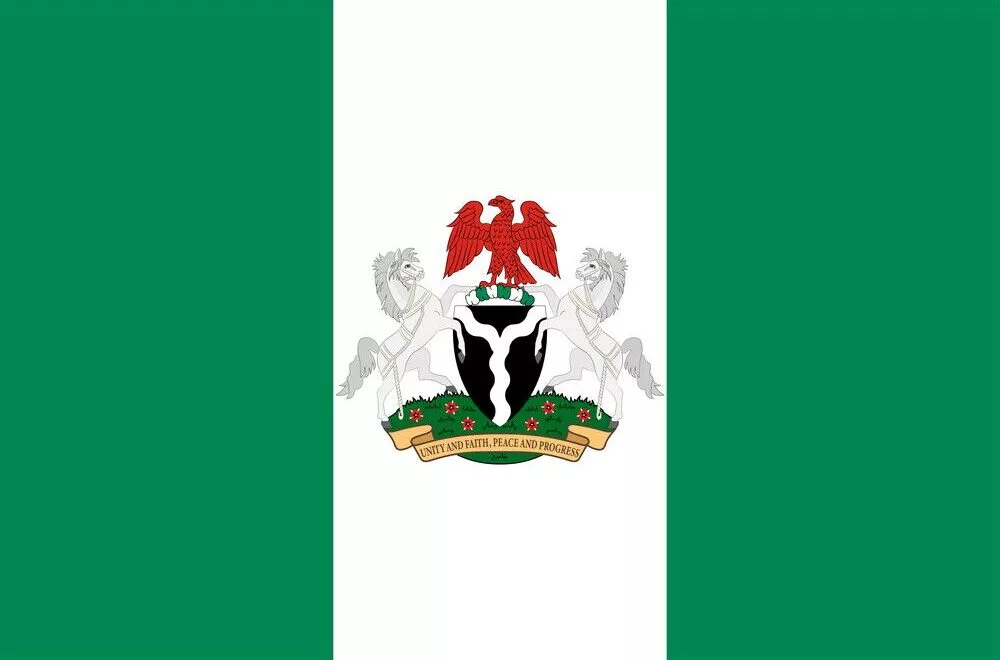Nigeria Coat of Arms & Nigerian Flag: History & Meaning
Nigeria is a country with a rich cultural heritage that is expressed through various symbols, such as the coat of arms and the national flag. These symbols represent the history and traditions of the country, as well as its people and values. In this article, we will explore the history, meaning, and significance of the Nigerian coat of arms and flag.

The Nigerian Coat Of Arms
The Nigerian coat of arms is a symbol of the country’s sovereignty, unity, and strength. It was adopted on March 20, 1960, just a few months before Nigeria gained its independence from Britain. The coat of arms features a black shield with two white stripes that form a Y shape. The black shield represents Nigeria’s fertile soil, while the two white stripes represent the country’s main rivers, the Niger and the Benue. On top of the shield is a green and white band that represents the rich soil and the abundant natural resources of Nigeria.
The Eagle
The most striking feature of the coat of arms is the eagle that sits on top of the shield. The eagle is a symbol of strength and courage and represents Nigeria’s aspirations for a bright future. The eagle is depicted with its wings outstretched, ready to soar into the sky, representing Nigeria’s aspirations for greatness.
The Red Flowers
Below the shield and eagle are two red flowers, which are Costus spectabilis, Nigeria’s national flower. The flowers represent the beauty of the nation and the diverse people who live there.
The Nigeria coat of arms was officially adopted in 1975. It represents the country’s symbol of national unity, state power. It was created together with the National Flag and was approved by Her Majesty, Queen Elizabeth II in 1971.
The Nigerian coat of arms was designed by a Bahamian artist and clergyman, Rev. Dr. Hervis L. Bain, Jr.
Features Of The Nigeria Coat Of Arms And Meaning
The Nigeria coat of arms has seven permanent features, symbolizing a particular entity or virtue about Nigeria:
- A black shield which represents the fertile soil in Nigeria.
- Two white wavy bands on the shield, which form the letter “Y” represent rivers Niger and Benue, the country’s main inland waterways.
- Two horses on either side of the shield represent the dignity of Nigeria.
- Some flowers which are yellow flowers at the base is the Coctus spectabilis, a specie of flower that grows in all parts of Nigeria.
- An eagle standing on the shield represents the strength of Nigeria
- The wreath (with green and white bands) upon which the eagles stands represents the rich agricultural produce of Nigeria.
- The nation’s motto on the band around the base of the shield is written, “Unity and Faith, Peace and Progress”, this motto was adopted in 1978. Before that time, the country’s motto was formerly “Peace, Unity, and Freedom”.
The Nigerian Flag: History & Meaning
The flag of Nigeria was designed by Michael Taiwo Akinkunmi in 1959 at the age of 23 during a competition. It was officially used on 1st December, 1960, the same day Nigeria got her independence from British rule.
Akinwumi who saw an advert that submissions for a new design for the national flag of Nigeria was ongoing in 1959 had his education at Norwich Technical College in London, England. His design was finally accepted and had a red radiating sun badge in the middle of the white vertical band with two green bands supporting the white by the sides.
Meaning
The Nigerian flag has three vertical colours. They are green, white, green. The green stripes represent Nigeria’s natural wealth, while the white stripe represents peace.
Aside the Nigerian flag, coat of arms, we also have the national anthem and the pledge. All these have their specific meanings, symbols and usage to show Nigeria’s sovereignty.
The Symbolism
The green, white, and red colors of the Nigerian flag each have significant symbolism. The green color represents Nigeria’s agricultural wealth, as well as its forests and abundant natural resources. The white color represents peace and unity, as well as the purity and innocence of the Nigerian people. The red color represents the blood of those who fought for Nigeria’s independence and the sacrifice that was made to achieve it.
Significance
The coat of arms and flag are two of the most significant symbols of Nigeria. They represent the country’s rich cultural heritage, its people, and its values. The coat of arms symbolizes the sovereignty and unity of Nigeria, while the flag represents its independence and the struggle for freedom.
National Unity
The coat of arms and flag also play an essential role in promoting national unity. They remind Nigerians of their shared history, culture, and traditions, and they serve as a source of inspiration and pride. They are a symbol of the country’s past and present and a guide to its future.
